Choosing between Constant Contact and Omnisend for email marketing platforms can be challenging.
Both platforms offer potent features that benefit businesses of all sizes.
Constant Contact is user-friendly with easy-to-use marketing tools, appealing to small businesses.
Omnisend specializes in automation and personalization for highly targeted email campaigns and automation.
Should you choose Constant Contact or Omnisend? Consider factors like time-saving features, pricing, integrations, and customer support.
Our comprehensive comparison will explore both platforms’ functionality, pricing, and support to help you find the best fit for your email marketing needs.
Constant Contact vs Omnisend: Quick overview
Omnisend has an impressive Shopify rating of 4.8. It excels in automation and personalization and has an intuitive interface. It also has excellent customer service, making it popular among businesses.
Conversely, Constant Contact has a lower Shopify rating of 3.5. But while its client support isn’t as exceptional, it offers solid performance. It also has a user-friendly interface to boot.
Check out the Constant Contact vs Omnisend comparison table. You’ll get a quick idea of their capabilities.
From this comparison, Omnisend stands out. It has an extensive range of modern-looking email templates. It also has robust email campaign analytics.
Let’s delve deeper into the Omnisend vs Constant Contact feature comparison. We explore each platform’s capabilities in more detail below.
Constant Contact vs Omnisend: Feature-by-feature comparison
We’ve explored the overall capabilities of Constant Contact and Omnisend. Now, let’s see how they compare in terms of:
- Ease of getting started
- Building an email campaign
- Marketing automation
- Signup forms and landing pages
- Segmentation
- Analytics
- Customer support
- Integrations
- Compatibility with other marketing channels
Let’s get going.
Ease of getting started
Both Constant Contact and Omnisend provide user-friendly experiences for beginners.
Constant Contact stands out with its straightforward signup process. It offers a risk-free free trial without requiring a credit card. Constant Contact also offers a unique 30-day paid plan refund guarantee.
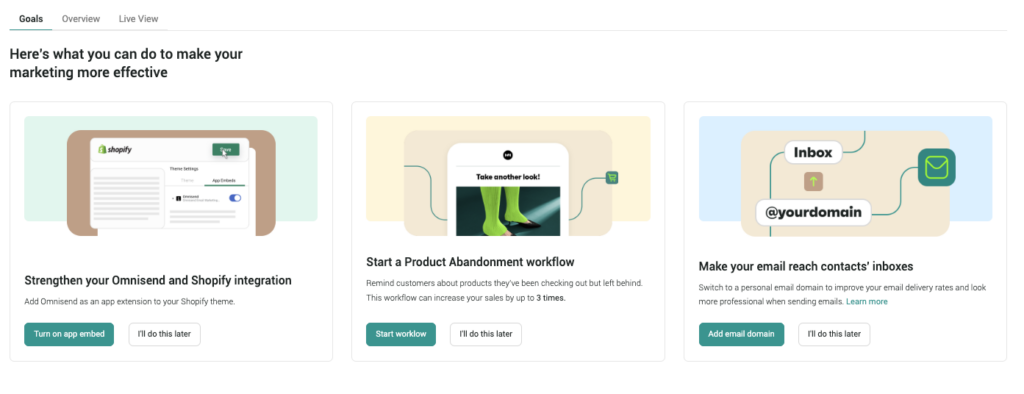
Similarly, Omnisend has a smooth signup process; you don’t have to use a credit card upfront. However, to exploit Omnisend’s power fully connecting your ecommerce store is essential.
In two simple steps, you can access all admin settings. This makes it exceptionally beginner-friendly. The initial home page provides clear instructions for maximizing the platform’s potential.
In Constant Contact, the settings section is also well-organized. The initial dashboard provides guidance and tutorials. This ensures straightforward navigation and understanding of the platform’s functionalities.
This round ends in a tie. Both Constant Contact and Omnisend provide a straightforward signup process.
Building an email campaign
Building email campaigns with either Constant Contact or Omnisend can be a breeze.
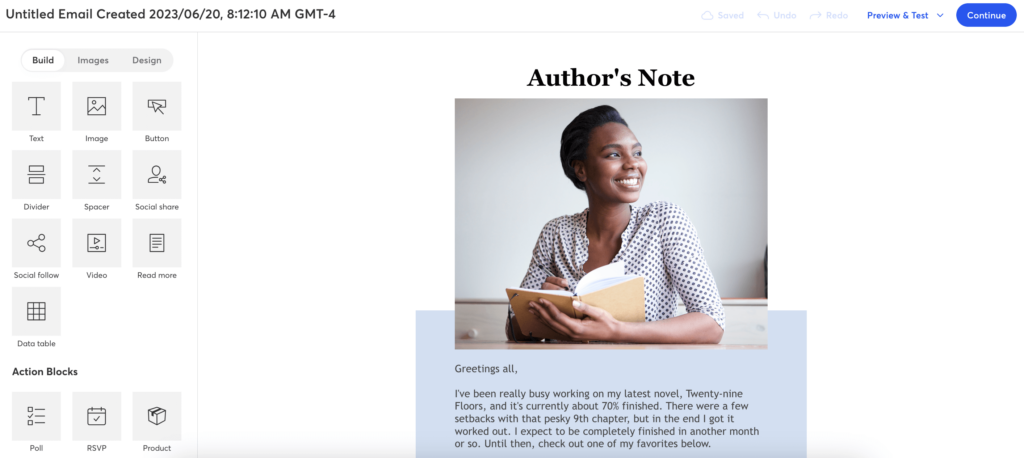
For starters, they both offer user-friendly experiences with their intuitive email builders.
Constant Contact provides a wide selection of email templates. Some may look a bit outdated, but most of them are fine.
On the other hand, Omnisend has modern-looking templates. If you set up the brand asset, they automatically pre-fills your brand logo, colors and fonts to those templates.
Both platforms offer personalization options, but Omnisend distinguishes itself with unique features. These include the product recommender, unique discount codes and “quick add” section.
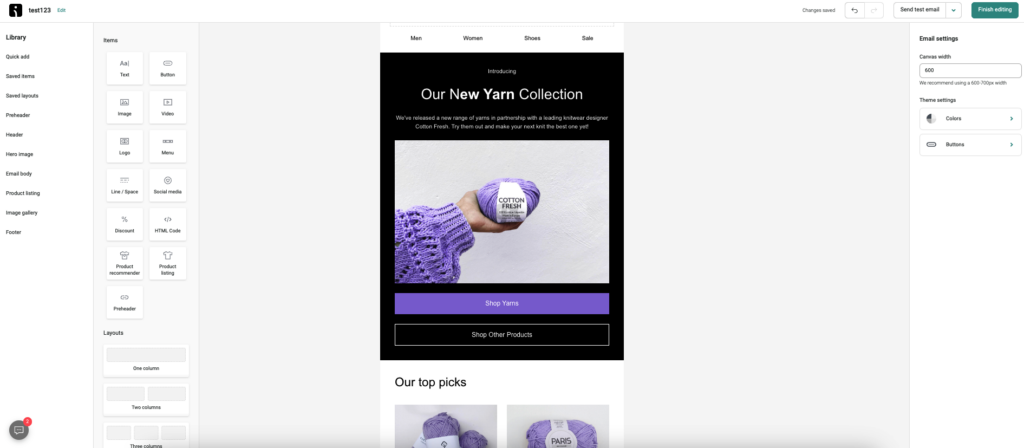
Omnisend’s Product Picker works in both automation workflows and email campaigns, allowing ecommerce clients to easily pull product images and descriptions from their stores. This feature can significantly save time and effort in your marketing efforts. While Constant Contact also offers a similar feature, Omnisend’s functionality is smoother and more user-friendly.
As for Constant Contact, its email-building wizard takes a slightly different approach. The campaign name, subject line, and preheader can be found in the email design builder. In other platforms, these entries are usually in separate steps. While this might be a bit unusual, it only takes a moment to figure out.
Constant Contact also offers a vast library of images that can be utilized for free on paid plans. However, trial users have access to a limited selection of free images.
Here’s a comparison of Omnisend vs Constant Contact in building email campaigns.
- Yes
- It has a user-friendly interface with clear navigation
- Yes
- It has multiple formatting and product listing options
- It has some outdated templates
- Also has selection of modern and occasion-ready templates
- 130+ modern-looking templates
- Multiple occasion-ready options
- Allows personalization through contact details in subject lines, email content
- Offers personalization options in the subject lines, preheaders, email content, and product recommendations.
- Promotional
- Automated
- A/B testing (with subject lines)
- All types of email campaigns
- AI-generated campaigns (beta) included
- Coupon content block with dynamic links
- Huge library of stock images
- Product recommender
- Unique discount codes
- Automatic brand asset application for emails
- Campaigns booster for non-openers
Omnisend wins this round of Constant Contact vs Omnisend comparison. It’s far more unique features further enhance the campaign-building experience.
Marketing automation
Marketing messages automation is crucial in streamlining your customer communication and maximizing engagement.
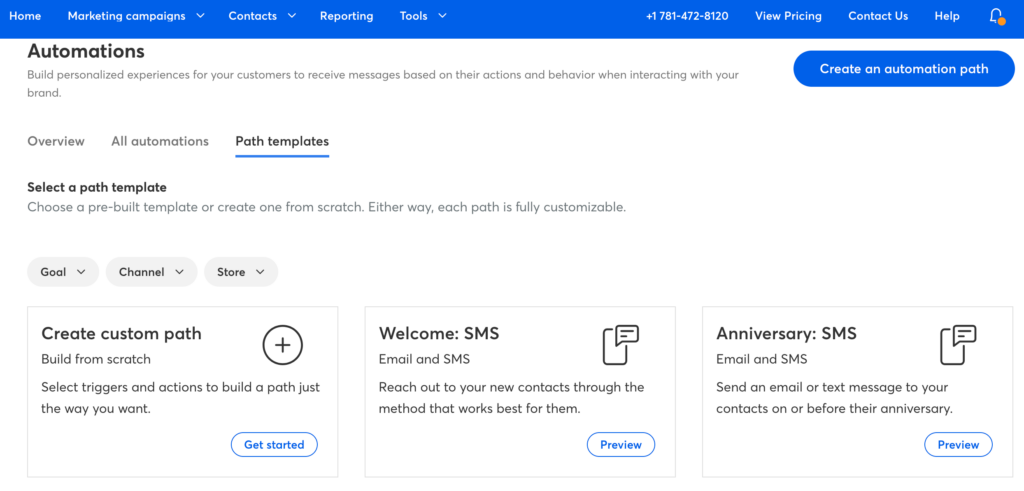
Constant Contact offers an intuitive and user-friendly automation interface. It has clear titles and specific functions. We found navigating through the automation features a breeze.
The platform provides 15 suggested marketing automation templates. Each of these is designed with logic and accompanied by a suggested copy. All you need to do is add your logo and make the necessary edits.
However, automation triggers in Constant Contact are relatively limited compared to Omnisend.
With Omnisend, there’s a wide range of options related to triggers, filters, and conditions. These allow you to create customized automation tailored to your specific needs.
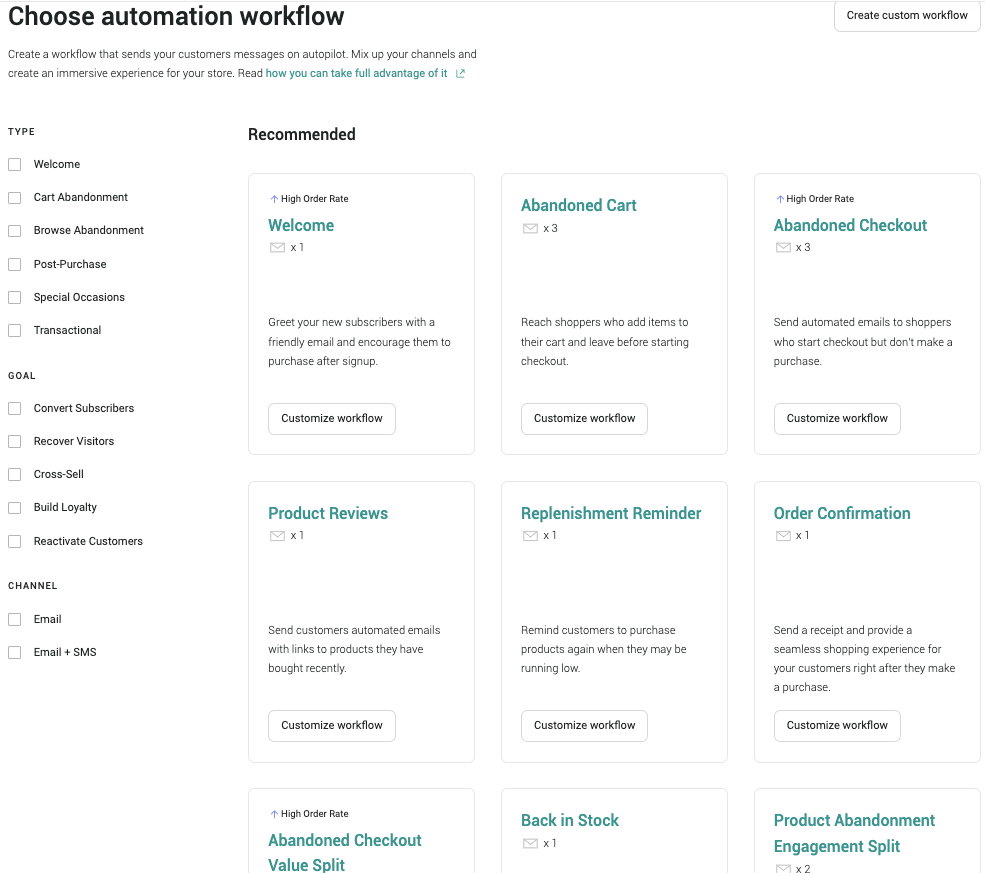
You also have access to 25 prebuilt automation workflows. These workflows encompass not only emails but also text messages and web push notifications. They provide an omnichannel approach to automation and can be launched immediately.
However, Omnisend’s historical data of advanced reporting is limited to 18 months. This may be restrictive for marketers requiring access to older information for analysis.
Let’s take a closer look at Constant Contact vs Omnisend in relation to marketing automation.
Clear and user-friendly interface
Very easy and intuitive to use
Yes, 15 suggested automation templates
Yes, 25 prebuilt automation workflows
Yes, but limited to SMS (at an additional cost)
Yes, SMS and push notifications
Yes, cover common ecommerce scenarios, but relatively limited
Yes, versatile triggers, filters, and conditions
Omnisend wins for providing a far more comprehensive set of features.
Signup forms and landing pages
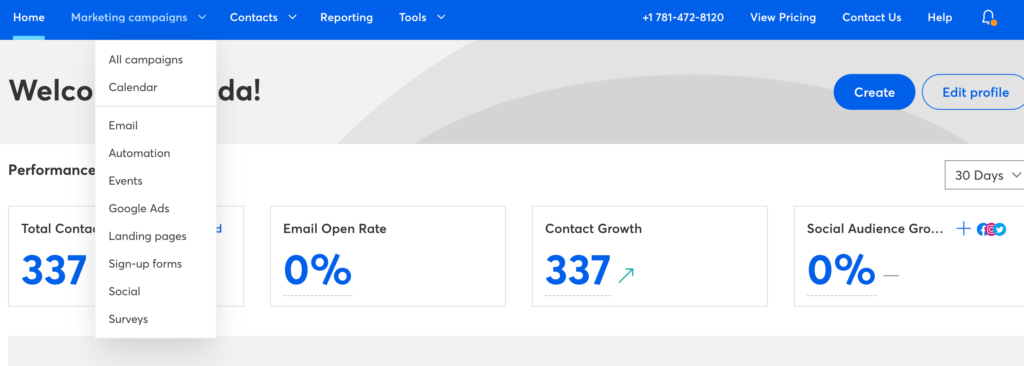
Signup forms and landing pages are critical in email marketing. They’re essential for capturing leads and engaging with audiences. As such, their availability is crucial when considering Omnisend or Constant Contact.
Constant Contact provides a basic form design that you can edit to match your brand style. However, there are no pre-built templates. This limits your options for creating visually appealing forms.
While there’s support for landing pages, Constant Contact only offers basic customization. That’s because it’s also missing templates to choose from.
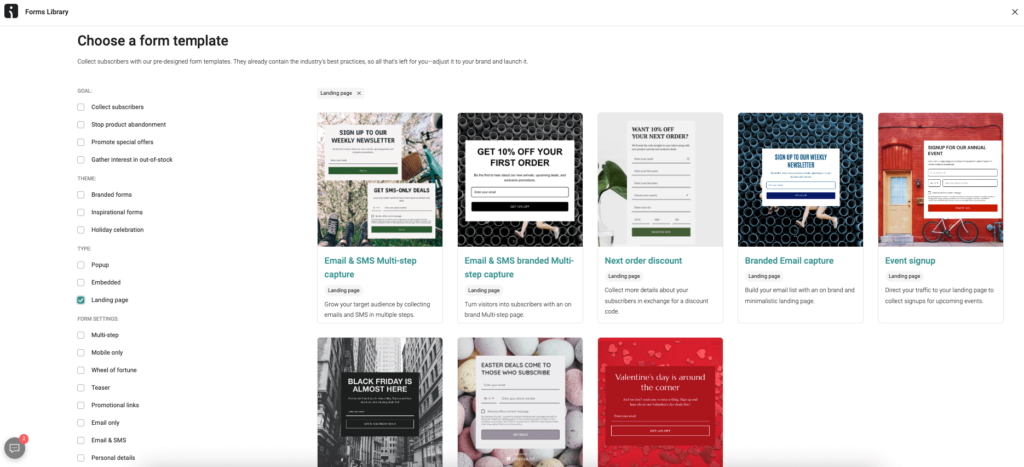
Omnisend, on the other hand, provides a wide range of pre-built signup forms and landing page designs. Analytics for signup forms are also available, as is a landing page editor.
Check out the following comparison table. It has more on the Constant Contact vs Omnisend’s signup forms and landing pages.
Limited basic design, editable
80+ modern designs, ready to use
Limited, no pre-built templates
Seamless with templates and easy adaptation to brand colors and styles
Provides metrics like submissions, conversion rate, etc.
Detailed analytics, including views, signups, conversion rate, geo-data, device info, etc.
Available with basic customization
Available with ready-to-use templates, customizable
Straightforward with tagging, lists, and segments
Easy management with tagging and advanced segmentation
- Templates for forms and landing pages
- A/B testing for signup forms
- Gamification aspect
- A/B testing for signup forms
Even with a missing feature for A/B testing, Omnisend wins. Unlike Constant Contact, it has pre-built templates, and gamification.
Segmentation
Opting for Constant Contact or Omnisend depends on how sophisticated you want to get.
Constant Contact offers four pre-built segments based on customer engagement levels:
- Most engaged
- Somewhat engaged
- Least engaged
- Everyone else
However, these segments lack specificity, making them less useful for advanced segmentation strategies.
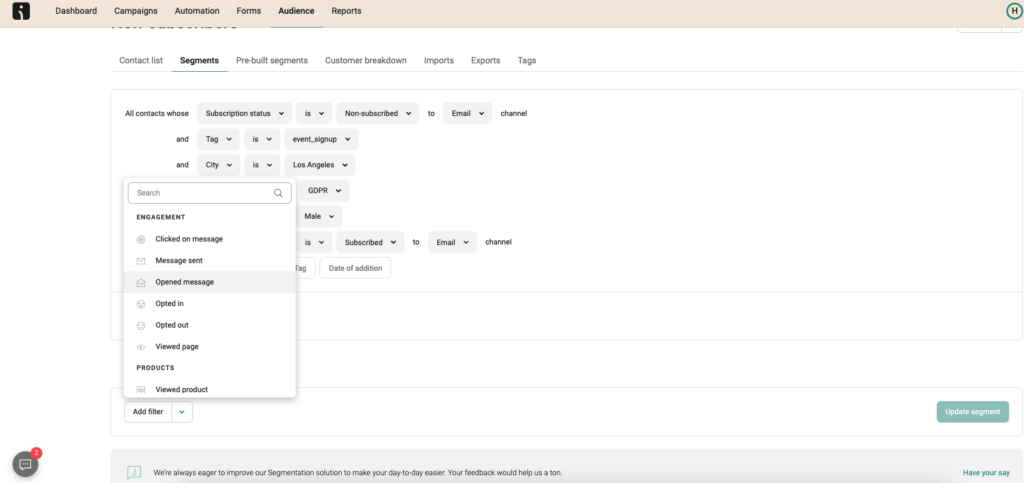
Conversely, Omnisend excels in segmentation capabilities, providing a powerful and flexible approach.
It has 23 pre-built segments available out of the box. These give you a wide range of options to target specific audiences.
Here’s how Constant Contact vs Omnisend compares in terms of segmentation.
Limited pre-built segments
23 pre-built segments available
- Basic
- Robust
- Powerful capabilities, including web-tracking filters
- List membership
- Contact details
- Tags
- Contact email activity
- Ecommerce activity
- Channels
- Shopping behavior
- Email campaign activity
- SMS campaign activity
- Contact properties
- Web browsing activity
- More pre-built segments
- Advanced segmentation criteria
- Lacks advanced criteria and on-site behavior criteria
- You can create segments based on customer journey stages, but not based on lifetime value, which is more usual.
This round of Constant Contact vs Omnisend sees Omnisend in the lead. It has a robust and flexible segmentation system with a wide range of pre-built segments. Conversely, Constant Contact trails due to limited pre-built segments and basic segmentation options.
Analytics
Both Constant Contact and Omnisend offer insights as part of their analytics capabilities.
Constant Contact focuses on providing an overview of campaign performance and workflow-specific metrics. The platform offers basic analytics with metrics such as:
- Sends
- Opens
- Clicks
- Bounced
- Unsubscribed
- Trends over time
In the automation part you will see revenue and order metrics.
However, Constant Contact lacks detailed ecommerce data, heatmaps, and a geo-location report.
Meanwhile, Omnisend excels in offering visual engagement data and campaign-specific metrics. These include email engagement metrics plus sales, and order numbers for each campaign.
Features like the click map report help visualize your audience’s engagement patterns. It does this by identifying the areas where they are active.
However, only the last 18 months of data in Omnisend’s advanced analytics are accessible. Historical data beyond that period isn’t available. Also, there are no geo-location reports.
Omnisend wins this round again. It’s able to provide marketers with deeper insights into campaign-specific metrics.
Customer support
Both Constant Contact and Omnisend offer commendable customer support options.
Constant Contact provides a wide range of support channels and resources. These ensure users get the help they need and include:
- Phone assistance
- Email support
- Help center
- Live chat
There’s an extensive collection of tutorials.
However, Constant Contact’s support is limited to working days. This can pose a constraint for urgent matters. Analyzing customer reviews, we found Constant Contact’s responsiveness to be a pain point for most of its customers.
Meanwhile, Omnisend has rave customer service reviews. It sets itself apart with its impressive 24/7 live chat and email support availability. This ensures round-the-clock help for all customers.
Further enhancing Omnisend’s customer support experience is a:
- Prompt response time
- Wealth of video tutorials
- Topic-rich blog
In this round of Constant Contact vs Omnisend, Omnisend emerges as the winner. Though it has no call support, Omnisend delivers exceptional support accessibility and responsiveness.
Integrations
Integrations are a vital aspect to consider when comparing Constant Contact and Omnisend.
Constant Contact offers an extensive library of over 300 integrations. These allow you to connect with popular platforms, including:
- Canva
- Vimeo
- Salesforce
- Eventbrite
- Gmail
These integrations ease customer engagement, enable email personalization, and improve marketing automation.
Omnisend excels in seamless integrations with leading ecommerce platforms, such as:
- Shopify
- BigCommerce
- WooCommerce
- Magento (versions 1 and 2)
- OpenCart
- Volusion
- Wix
Additionally, Omnisend provides integrations with various third-party apps available in their App Market. This gives users access to a broader range of ecommerce tools.
Constant Contact takes a narrow lead. It has an impressive range of options and depth of integrations. These empower users to create immersive and effective campaigns across multiple channels.
Meanwhile, Omnisend emphasizes store connections and third-party app integrations. These enhance the ecommerce experience for users.
Compatibility with other marketing channels
Establish which platform’s right for you by considering Constant Contact or Omnisend’s compatibility with other marketing channels. It enables you to extend your audience reach. It also helps you engage with them through various touchpoints.
Constant Contact provides integrations with popular social media platforms. It supports SMS marketing (US users). It also offers advertising campaigns through Google Ads and Facebook Ads.
Meanwhile, Omnisend combines email, SMS (international), and push notifications within a single platform. This way, Omnisend facilitates cohesive omnichannel campaigns.
Additionally, Omnisend has cart abandonment retargeting capabilities through Facebook and Google Ads. This provides valuable opportunities to recover potentially lost sales.
Omnisend has a unique ability to unify communication across multiple channels. This empowers marketers to deliver consistent messaging while engaging with their audience.
Omnisend wins this round for its comprehensive approach. This includes seamless integration of email, SMS, push notifications, and retargeting capabilities.
Price Comparison
When considering an email marketing platform, understanding the pricing options is crucial.
Evaluate specific features and pricing details. Then, make an informed decision based on your business requirements and budget.
Let’s dive into the Constant Contact vs Omnisend price comparison. We’ll break it down into their free (or trial) and paid pricing plans.
Free plans comparison
Constant Contact doesn’t offer a free plan. Instead, you’re granted a 60-day trial period. Interested users can use it to explore the platform’s features and functionalities.
In contrast, Omnisend offers a free plan for users. With the Omnisend free plan, you can benefit from all the platform’s benefits. These include automation and advanced segmentation.
Here’s a closer look at the Constant Contact vs Omnisend trial/free plan offering.
- 100 email sends (emails sent to unique contacts) limit
- Certain features locked (like publishing signup forms)
- Limited segmentation capabilities
- No credit card required
- 250 contact limit, 500 emails/month, up to 60 SMS and 500 web push notifications
- All features accessible (but with Omnisend branding)
- Unlimited segmentation
- No credit card needed
In the free plans comparison, Omnisend clearly takes the lead for its generous free plan. It includes automation, advanced segmentation, and custom workflows. It also has professional templates, unlimited landing pages, and gamification features.
This is an excellent option for beginners. It’s also ideal for those who want to explore the platform without incurring costs.
Paid plan comparison
Both Constant Contact and Omnisend offer flexible pricing based on subscriber numbers.
Omnisend has Standard and Pro paid plans. Both plans unlock all features, except from advanced reporting which is available on Pro only. Also, Pro plan gives you more SMS.
Constant Contact has Lite, Standard, and Premium paid plans. This platform locks features for lower tier plans, and unlock for higher ones.
Omnisend touts the Standard plan as ideal for growing and medium-sized businesses. Its mainstay is email marketing. As for ecommerce businesses with comprehensive customer data, the Pro (Email + SMS) plan is ideal. It offers more SMS tokens and advanced reporting.
Meanwhile, Constant Contact’s Lite plan provides a basic suite of email and marketing tools. The Standard plan offers automation and segmentation tools. As for Premium, it has SEO and advanced segmentation offerings.
In this round of Omnisend vs Constant Contact, Omnisend takes the prize. It has more affordable pricing options and features.
Constant Contact vs Omnisend: Which one wins?
We’ve explored Omnisend vs Constant Contact’s key features, capabilities, and user experiences. Now, it’s time to determine which platform comes out on top.
Let’s take a closer look at their strengths and limitations to reach a verdict.
3.5
4.8
Free plan – No
500 subscribers – $12
1,000 subscribers – $30
5,000 subscribers – $80
10,000 subscribers – $120
50,000 subscribers – $430
50,000+ subscribers – Custom pricing
Free plan – Yes
500 subscribers – $16
1,000 subscribers – $20
5,000 subscribers – $65
10,000 subscribers – $115
50,000 subscribers – $330
100,000 subscribers – $720
- Easy to get started
- Great compatibility with other marketing channels
- Robust automation
- Advanced analytics
- Beautiful signup forms
- Modern-looking newsletters
- Better price
- Basic signup forms and landing pages
- Basic reports
- Higher price
- No geopolitical report
- Advanced analytics for 18-months period only
- Easy and hassle-free onboarding
- Gamification in signup forms
- Seamless integration with ecommerce platforms
- Unique discount codes
- Ecommerce beginners
- Non-profit organizations
- Ecommerce stores of all sizes, both beginners and advanced users
- Lifestyle bloggers
- Well-established ecommerce businesses
- Solopreneurs
- Bloggers
- Governmental and non-governmental organizations
Here’s our final verdict:
Constant Contact emerges as an excellent option for ecommerce beginners and non-profit organizations. It offers easy onboarding, excellent integrations, and compatibility with other marketing channels.
On the other hand, Omnisend caters to ecommerce stores of all sizes, from beginners to larger ones. It provides robust automation, advanced analytics, and visually appealing templates.
Ultimately, the right choice depends on finding the perfect fit for your unique needs.
So, evaluate your specific needs and consider the pros and cons highlighted. Then, select the platform that aligns best with your business requirements and objectives.
You may also want to check best Omnisend alternatives and best Constant Contact alternatives.
Our team strives to be accurate and unbiased in reviewing email tools. However, we recognize that mistakes can happen, and it’s essential for us to stay up to date. If you come across any errors or things that need to be reviewed again, please let us know.


Leave a Reply